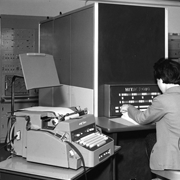Hitachi developed the HITAC 2010 on its own as the successor to the HITAC 3010/4010 and completed the machine in 1964. At this time, calculations done in decimal used decimal addressing and calculations done in binary used binary addressing. The HITAC 3010/4010 used this addressing methodology, but the HITAC 2010 used binary addressing for all calculations. In addition to the binary calculations needed to calculate addresses, the 2010 was supplied with decimal calculation functions and functions that handled characters (one character was represented by 6 + 1 bits). The smallest addressing unit was a character. The word length was defined as 24 bits so that one word held four characters, and floating-point operations were also designed around the six-bit character architecture. The HITAC 2010 could add and subtract about three times faster than the 3010.
However, the IBM System/360, which was announced in 1964, extended the character length from six bits to eight bits, and eight bits became the smallest addressing unit. The HITAC 2010 did have some functions to handle eight-bit characters, but not all functions could handle eight-bit characters and the minimum addressing unit remained six bits. Thus, IBM’s announcement effectively killed the commercialization of the HITAC 2010.
Two systems were prototyped, and one system was used for computer control research at Hitachi’s Central Research Laboratory. The other system was used for several years for testing large multilayered backboards for the HITAC 8000 series at the company’s former Kanagawa Plant.
The photo shows the HITAC 2010 used at Central Research Laboratory.


